Germany’s coalition parties. Chancellor Angela Merkel’s conservatives (CDU/CSU) and the Social Democrats (SPD), have agreed a compromise on the reform of the EEG 2021 green energy law, clearing the way for approval by parliament by Dec. 18, energy minister Peter Altmaier (CDU) and environment minister Svenja Schulze (SPD) said Dec. 14.
Decisions on greater renewable energy volumes required to meet EU 2030 climate targets, however, were pushed into early 2021, they said.
The compromise has focused on improving support for first-generation wind and solar assets coming out of subsidy periods.
The latest draft lifts the floor on solar roof-top projects that have to compete in auctions from 500 kW to 750 kW. It introduces extra tenders for floating solar and agri-PV. It exempts self-consumption of solar up to 30 kW from paying the EEG levy, and grants an exemption to a smart meter requirement for older solar system. It also increases support for solar roof-tops in larger residential blocks.
Some 4 GW of first-generation wind capacity coming out of support as of end-2021 are to receive a Eur10/MWh premium plus spot market prices to allow for continued operation, wind association BWE said.
To encourage acceptance of new wind projects, host communities are to receive financial contributions from projects.
The BWE welcomed the changes, but regretted the lack of initiatives to accelerate permitting.
2030 target debate moved to early 2021
Parliamentary party leaders agreed that, in the light of the newly-agreed EU target to cut CO2 emissions by 55% to 2030, Germany would need to lift its own targets and volumes, with the EEG 2021 draft detailing a pathway to achieve a 65% share of renewables in the power mix by 2030 based on 2018 demand.
Details on that would follow in the spring of next year.
In a statement, the CDU/CSU and SPD said market conditions for renewables improved with the rise in EU CO2 prices as a direct consequence of the higher 2030 targets as well as a new CO2 tax for non-Emissions Trading System sectors transport and heating to be launched in 2021.
Part of that income will be used to cap the annual EEG levy already capped at Eur65/MWh for 2021 and Eur60/MWh for 2022 with higher RES volumes not leading to higher payments or subsidies.
Altmaier specifically referred to solar and its much lower cost as a key factor that would allow Germany to set itself higher targets.
German solar is growing at its fastest since 2012 with almost 5 GW added 2020 bringing total installed capacity to 53 GW.
The draft EEG 2021 targets 100 GW by 2030.
Onshore wind growth rebounded slightly from 2019 when the turbine boom that boosted capacity above 50 GW by 2018 ground to a halt following the move to competitive tenders 2018 with new permits slowing to a trickle.
German RES covered some 46% of demand in 2020 generating some 252 TWh with wind (including offshore) accounting for 133 TWh and solar 50 TWh, utility lobby BDEW said Dec. 14, with 2020 demand down 4% to an estimated 544 TWh.

 Iran Energy News Oil, Gas, Petrochemical and Energy Field Specialized Channel
Iran Energy News Oil, Gas, Petrochemical and Energy Field Specialized Channel



